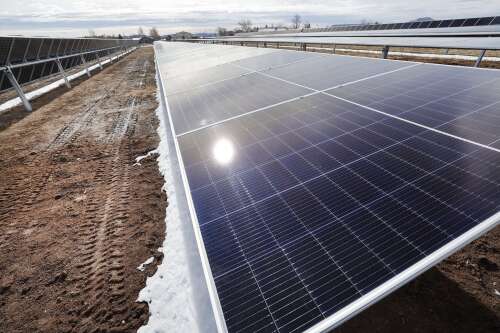Co-op one of five organizations to receive first-round funds from $1 billion Inflation Reduction Act program
La Plata Electric Association and the U.S. Department of Agriculture announced Wednesday that the co-op would receive $13.4 million in federal funding to build a 5 megawatt solar production facility. The Sunnyside Community Solar Garden, pictured here, is LPEA’s first solar project and should be online by the end of this summer. (Jerry McBride/Durango Herald)
U.S. Secretary of Agriculture Tom Vilsack has announced a national roster of clean energy investments, including a $13.4 million award to La Plata Electric Association. The funding will support construction of a facility with capacity to generate and store 5 megawatts of solar energy in LPEA’s service area.
Questions surrounding the cost comparison and reliability of local generation have taken center stage in discourse over LPEA’s future in recent years. But with the co-op’s first local solar project slated to come online this summer and funding for another now secured, the power distributor is running, not ambling, toward local green energy production.
“We’re going full throttle ahead,” said LPEA Executive VP of Grid Solutions and Special Projects Dan Harms.
The funding comes from the Powering Affordable Clean Energy program, known as PACE. The $1 billion pot of money was established in the 2022 Inflation Reduction Act, which is the centerpiece of President Joe Biden’s push to combat climate change. Vilsack on Tuesday announced $139 million total in funding for PACE projects across five states.
In a news release, LPEA spokeswoman Amanda Anderson said the program received $12 billion in funding requests – 12 times the total size of the program – and that the pool of applications was “highly competitive.”
“As rural communities in La Plata County face high energy costs and the threat of climate-fueled disasters, it’s more important than ever to invest in affordable clean energy,” said Colorado Sen. Michael Bennet in a statement made through a spokesman. “Thanks to this funding from the Inflation Reduction Act, La Plata Electric Association can take critical steps to deliver more clean energy at a lower cost to Coloradans living in rural communities.”
The funding allocation is technically a loan, of which 40% is likely to be forgiven upon project completion. With the availability of federal tax credits that could fund an additional 30 or 40% of the project, Harms said the solar array is likely to be a “very economical project.”
Many of the specific details around the project, such as its location, remain hazy. Planning is still in the early stages. Harms said LPEA is focused on building a 5 megawatt solar array as well as a 5MW/20 megawatt hour battery bank (a 20MWh bank can distribute 1 megawatt of power for 20 hours, or 2 megawatts for 10 hours, for example).
The project will have the capacity to power up to 1,800 homes, outgoing LPEA CEO Jessica Matlock said in a news release.
This will be the first LPEA project involving the storage of solar power, which Harms said will be a fun engineering challenge.
LPEA is already generating 5% of its customers’ power locally, the maximum amount allowed under a restrictive contract the co-op has with its wholesale energy provider, Tri-State Generation and Transmission Association. Under the terms of the contract, which is in effect until 2050 unless LPEA successfully negotiates a partial or full buyout, LPEA must pay Tri-State an annual fee for any power it generates that exceeds the 5% limit.
Despite the fact that this project will push LPEA well past the 5% self-generation cap, the co-op is acting with an eye to the future, Harms said. Negotiations over a contract exit are ongoing.
“We’re stacking the opportunities up for ourselves,” Harms said. “… Things like this make complete and total sense and it’d be silly not to take advantage of that. We got to get these kinds of opportunities while the opportunities exist.”
LPEA has time to get its ducks in a row when it comes to the local generation fees. The project won’t come online for at least three years, Harms said, by the time that permitting and construction is completed.
“This project marks a pivotal step forward in our commitment to affordable, renewable energy,” Matlock said.
The co-op’s first solar project, the Sunnyside Community Solar Garden, is expected to come online this summer.















